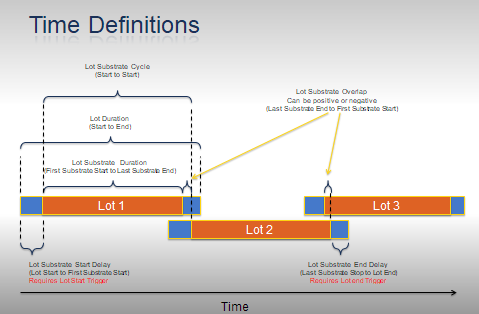October 2017
SPC Effectiveness Metric: Are FabGuard Reports Working Correctly? »
Automatically Track Lot Processing Times for Industrial Engineering »
Automatically Calibrate Transpector® CPM RGA »
Modbus® TCP Connectivity in FabGuard »
Arc Detection using S-Probe Sensors on 200 mm High Density Plasma (HDP) Chambers »
Automatically Track Lot Processing Times for Industrial Engineering
Unlike process engineers who are concerned with proper wafer chemistry or equipment engineers who are maintaining the tool hardware, industrial engineers are responsible predicting and monitoring tool utilization and loading. They make sure that the tool is processing as many wafers as possible, supervise Manufacturing Execution System (MES) wafer scheduling, and maintain the complex movement of wafers in the factory. This task is made significantly more difficult in factories that produce a high number of parts. With constantly changing process flows, factories need data to perform optimization calculations. FabGuard® is uniquely positioned to provide data for factory optimization. FabGuard knows the location of every wafer in every chamber on every tool at all times.
Currently, extracting the Industrial Engineering (IE) data is performed manually. FabGuard provides a Tracking and Utilization Summary Report that shows the location of each wafer in a tool as a function of time. It also calculates Utilization, defined as the ratio of time spent in a process over total time. Executing the Report using a Report Task saves the Utilization table which allows industrial engineers to extract valuable information.
A new FabGuard feature automates generating this information for IE. FabGuard automatically creates Equipment Performance Indicators (EPIs) that directly track key IE information and allow automated application of SPC reports to IE values. This feature shifts the work from industrial engineers to FabGuard allowing automated email notification and tool interdiction if key IE metrics change.
IE Parameters
It is very important to understand the parameters used in automated IE calculations. The majority of IE optimization is lot based, rather than wafer based.
There are three key parameters:
- Lot Substrate Duration: The time between processing of the first substrate in the lot and the last substrate in the lot.
- Lot Substrate Gap: The time between processing of the last substrate in the lot and the first substrate in the next lot.
- Lot Substrate Cycle: The time between processing of the first substrate in the lot and the first substrate in the next lot.
Accurate IE calculations using these defined parameters can only occur if there is no user or MES interference with wafer processing. Additional constraints have been applied to lots that are included in the calculation pool. Lots must satisfy these specific criteria:
- Substrates must be available when the tool is ready to process them. For example, if there are two load ports on the tool, the second lot must be placed and ready for processing before the first lot is completed.
- Lots must contain 25 wafers.
- Lots must reflect standard processing recipes and sequences. Lots with special processing will not be included.

Figure 1: Graphical representation of the Lot Substrate Duration, Gap, and Cycle IE parameters.
Implementation Details
IE calculations are enabled in the Acquisition tab of FabGuard Web Global Preferences. Once enabled, every FabGuard IPM will generate three lot summary EPIs: Duration, Gap and Cycle. Unlike most other EPIs, no EPI configuration is required in I/O. The EPIs will be automatically generated after the next lot ends. Lot end is either determined by Lot End Trigger or by a lot having no new processes for a lot for 24 hours. There will be a 24 hour delay if no Lot End Trigger is configured. For example, the first lot processed is A and the second lot processed is B. When lot B ends, information for lot A will be generated.
The names of the three EPIs are:
- FabGuard Lot Substrate Duration
- FabGuard Lot Substrate Gap
- FabGuard Lot Substrate Cycle
For proper analysis, Reports will need to filter lots that are not applicable for IE calculations. Several logistic fields in the generated EPIs contain custom information:
- Sequence ID: A space delimited list of all Sequences used during substrate processing.
- Recipe ID: A space delimited list of all tool Recipes used during substrate processing.
- Extra 1 ID: A space delimited list of all FabGuard Chamber Numbers used during substrate processing.
- Extra 2 ID: The substrate count in the lot.
- Extra 3 ID: The Gap duration in minutes.
- Value: The Duration, Gap, or Cycle time in seconds.
Example of Use
Industrial Engineering EPIs can be used in two ways. First, the factory can configure an automatic database query to extract the values from the FabGuard database. Second, the factory can configure an EPI SPC Report to track variation in the values and fault or interdict as required. The extra information in the EPIs should be used to filter values that do not match user criteria.
For example, if only lots with 24 or 25 wafers are to be analyzed, set the Extra 2 filter in the Report to be 24, 25. If only lots with no or negative gap are to be analyzed, set the Extra 2 filter in the Report to be -*, 0.
Future FabGuard versions may include additional automatic EPIs. For example, it may be advantageous to know the time between last substrate processing and lot removal from the tool (Lot End Delay). While this requires a Lot Stop Trigger to be configured, the information may indicate the speed and effectiveness of the automation system used to move wafers to the next process.
Summary
The new automatically generated IE EPIs allow Industrial Engineers to track key product timing information with minimal configuration. Email notification and tool interdiction provide factory protection when key IE metrics change.